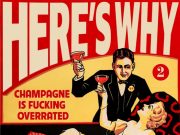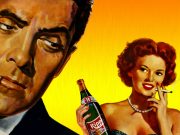“The martini,” Dr. Giorgio Lolli wrote in his seminal 1960 book Social Drinking, “conveys the impression of a powerful stillness.”
A mix of gin and vermouth (the less vermouth, the drier the cocktail), poured into a long-stemmed v-shaped glass and topped off with a single green olive, the martini has always appealed to purists. Although it was invented in the Old West and first popularized during the Depression, the martini remains a symbol of swank ‘50s and ‘60s bachelors, such as the perpetually stewed Rat Pack and international super spy James Bond. It is with the latter, Ian Fleming’s creation, that a battle really began, because, purists-be-damned, the martini would not stay still.
Of course, daring mixologists had toyed with the martini’s recipe in the past. Joseph Lanza devotes an entire chapter in The Cocktail: The Influence of Spirits on the American Psyche to what he calls “The Frankenstein martini (Mangled, not Shaken!)” Lanza, who seems ready to leap into a fistfight over the issue, describes in tones of pure horror how Franklin Delano Roosevelt added fruit juice to his drink and “inadvertently used aquavit instead of gin on one occasion.” But it was Bond, with his peculiar Cold War combination of sophistication and internationalism, who transformed the martini by replacing gin with vodka. In a drink that had only two liquors, Bond was replacing one of them altogether!
Perhaps there would not have been such an uproar had he swapped the vermouth for something else—after all, fans of dry martinis had long been weeding vermouth out of the picture. But gin is the martini’s main ingredient. What had Ian Fleming been thinking? Not only was his Western hero consuming a Russian drink, but he was perverting the drink that most represented Western sophistication!
Fans of the traditional cocktail could only assume Fleming meant to imply James Bond was a double agent. Double agent or not, as serialized in Playboy, James Bond became a hero to millions of young swingers who quickly adopted the vodka martini as their drink of choice. Why not? This new mixture maintains the martini’s glacier coolness, its freezing stillness. Gin and vodka both originate in Eastern Europe, so Bond was simply swapping one clear-colored European liquor for another. Besides, as anyone who has read Paul Fussel’s book Class knows, vodka is the preferred drink of the wealthy elite. And to many, the vodka martini tastes better. Objectively, Ian Fleming had created a better drink.
So why the fuss? It might be because purists realized they were a small group of Roman centurions and the barbarians were at the gates. The vodka martini might have been a civilized barbarian, speaking Latin and dressed in silk, but lurking behind him were savages dressed in furs and wielding axes. Once the centurions allowed the vodka martini, anything at all could claim the name martini, and Rome would fall.
They were right. The ‘60s and ‘70s saw a wild explosion of mixed drinks claiming to be martinis but including everything from sake to soda. With the explosion of lounge culture in this decade, the bastardized martini grew even sillier. Scenesters dressed in zoot suits and jitterbugging to new swing music demonstrated their ersatz sophistication by ordering martinis with violet liqueur or crème de cacao, transforming the once noble martini into an upscale buttery nipple. And, as Fussel also points out in Class, as drinks get more sugary they descend the social ladder.
The martini, although still favored by young sophisticates, is at risk of joining the “Champagne of Beers” as the drink of choice among the supremely tacky. The word martini has become so discombobulated that a purist, desiring the classic gin and vermouth mixture, must be very specific in placing an order at most bars or risk receiving a vodka drink or something made of rosemary and Goldschläger that has taken to calling itself a martini.
For most, this does not matter. After Gertrude Stein, they argue that “liquor is a liquor is a liquor,” or perhaps more properly, “drunk is a drunk is a drunk,” and do not care what they use to drown their daily stress. For others, however, the martini exists as much as a symbol as it does a drink. Dorothy Parker said of them, “martinis, my dear are dangerous. Have two at the very most. Have three and you’re under the table. Have four and you’re under the host.” Oil tycoon John D. Rockefeller guzzled his (extra dry, thank you) at New York’s famous Knickerbocker hotel, while Nick Charles lectured bartenders about the proper mixing of the martini in the film The Thin Man. None of these cocktails had a hint of vodka, nor did they include weird admixtures.
When people of days past talked about the martini, there was no confusion, no possible misinterpretation of their meaning. It was gin, vermouth and olive and that was it. The martini has moved through the 20th Century as much as an emblem of high culture as a drink. It may not matter if the martini recipe has changed. It should not have mattered when Coca-Cola changed its secret formula. There is something natively American about resisting such change, perhaps because we are creatures of habit. We do not wish to go to Fort Lauderdale, Fla., tomorrow and discover it has changed its name to New York City, because we will not be able to find the Flatiron building. Likewise, we don’t wish to swallow a mixture of cherry juice and ginger ale and have somebody tell us it is a martini.










